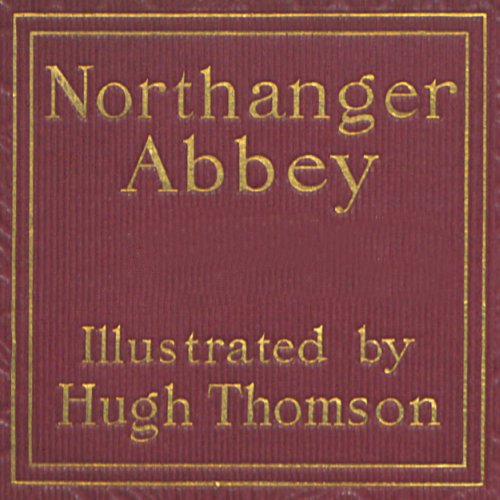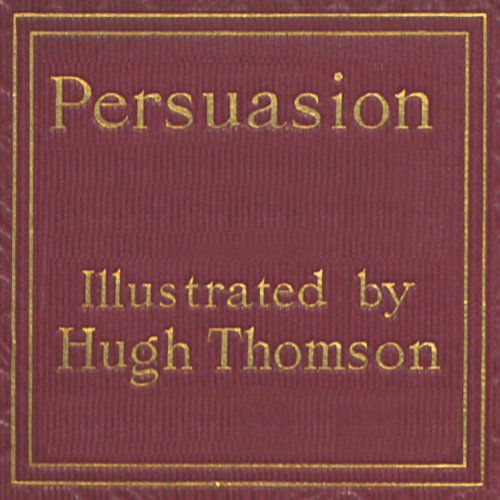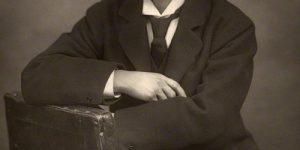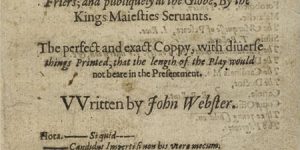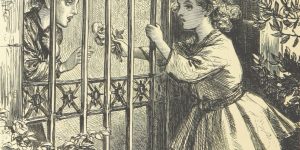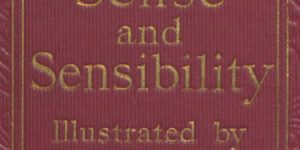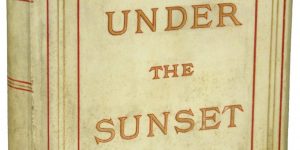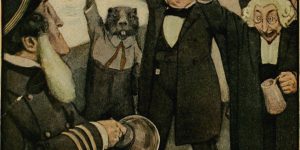Northanger Abbey and Persuasion Introduction by Austin Dobson
Northanger Abbey and Persuasion Introduction by Austin Dobson
EVEN at this distance of time, the genuine devotee of Jane Austen must be conscious of a futile, but irresistible, desire to ‘feel the bumps’ of that Boeotian bookseller of Bath, who having bought the manuscript of Northanger Abbey for the base price of ten pounds refrained from putting it before the world. What can have been the phrenological conditions of a man who could remain insensible to such a sentence as this, the third in the book- ‘Her father was a clergyman, without being neglected, or poor, and a very respectable man, though his name was Richard and he had never been handsome’? That the sentence was an afterthought in the proof cannot be contended, for Northanger Abbey was published posthumously, and ‘the curious eyes, that saw the manners in the face,’ had long been closed under a black slab in Winchester Cathedral. Only two suppositions are possible:- one, that Mr. Bull of the Circulating Library at Bath (if Mr. Bull it were) was constitutionally insensible to the charms of that master-spell which Mrs. Slipslop calls ‘ironing’; the other, that he was an impenitent and irreclaimable adherent of the author of the Mysteries of Udolpho. The latter is the more natural conclusion. Nothing else can explain his suppression for so long a period of Miss Austen’s ‘copy’ the scene of which, by the way, was largely laid in Bath itself. He was infatuated with Mrs. Radcliffe, and Mrs. Radcliffe’s following : the Necromancer of the Black Forest, the Orphan of the Rhine, the Midnight Bell, the Castle of Wolfenbach, and all the rest of those worshipful masterpieces which Isabella Thorpe, in chapter vi., proposes for the delectation of Catherine Morland, and the general note of which Crabbe (one remembers Miss Austen’s leaning to that favourite poet[1]) anticipates so aptly in The Library :
Hence, ye profane! I feel a former dread,
A thousand visions float around my head :
Hark ! hollow blasts through empty courts resound,
And shadowy forms with staring eyes stalk round.
But whatever be the solution, the fact remains. Northanger Abbey, as the ‘Advertisement’ to the first edition of 1818, said to be by the then deceased ‘authoress,’ informs us, was disposed of to a Bath bookseller and even announced as forthcoming, not long after it ‘was finished [i.e. prepared for press] in the year 1803,’ having been ‘certainly first composed,’ Mr. Austen-Leigh states, as far back as 1798 (the year after the first appearance of Mrs. Radcliffe’s Italian), when Sense and Sensibility and Pride and Prejudice were already existent in manuscript. ‘That any bookseller should think it worth while to purchase what he did not think worth while to publish seems extraordinary,’ observes Miss Austen ; and it would seem more extraordinary still were there not several other equally well-authenticated instances of similar lack of enterprise or critical incapacity in those whose business lies in books. That this particular wiseacre should not have found out, after the successful publication of the first two novels, that he had an unprinted MS. by the same author in his own possession, is also extraordinary; and, all things considered, no one can greatly commiserate him when, in the absence of such knowledge, he was induced to sell back Northanger Abbey to Henry Austen for precisely the same amount he had paid for it at the beginning.
It has been said that we have Northanger Abbey in its original form – in other words, that it was not subjected, like Pride and Prejudice and Sense and Sensibility, to reconstruction or revision long after it was first completed. That, subsequent to its recovery from the Bath bookseller, it was practically untouched by its writer, is clear from the ‘Advertisement’ above quoted, which expressly apologises for those parts of it which had grown ‘comparatively obsolete’ in the thirteen years which had elapsed since it was finished (a statement which gives us 1816 as the date of the advertisement). But Miss Austen also adds that ‘many more years had passed since it was begun.’ Much, therefore, may have been done to modify and alter it between 1798 and 1803. Miss Austen, as we know, in her girlish efforts, had amused herself by ridiculing the silly romances of the circulating library, and it is probable that Northanger Abbey was originally only a more serious and sustained attempt to do for the Radcliffe school what Cervantes had done for Esplandian and Florismarte of Hyrcania, and Mrs. Lenox for Cassandra and Cleopatra. But the ironical treatment is not always apparent, and there are indications that, as often happens, the author’s growing interest in the characters diverts her insensibly from her purpose. There are, besides, passages, such as the spirited defence of novels at the end of chapter v., with its odd boutade against the Spectator, which have a look of afterthought;[2] and it is not very unreasonable to assume that, setting out with a purely satiric intent, Miss Austen ultimately moved in a diagonal between a study in irony and a story. One result of this is, that her attention not being wholly confined to the creation of character, her third novel (in the order of writing) contains no personage corresponding to Mr. Collins, or to the Mrs. Norris of her next book. But Mrs. Allen is ‘perfectly well’ (as Gray would say) in her colourless kind ; and as a mere study there is nothing anywhere to approach, in its vivid fidelity, that extremely objectionable specimen of the horsey university man of the Gillray and Rowlandson era, Mr. John Thorpe, who, it may be noted, admires Mrs. Radcliffe and abuses Miss Burney. Of Catherine Morland it is perhaps sufficient to say that she is attractive in spite of her environment and her function, and that her native sense of fitness is stronger than her fictitious enthusiasm. She is evidently the person really intended when Henry Tilney speaks mockingly of Isabella Thorpe as ‘open, candid, artless, guileless, with affections strong but simple, forming no pretensions, and knowing no disguise,’ and, like the hero and his sister, we instinctively feel her unlessoned charm to be greater than her acquired opinions. Personally, we could have willingly surrendered a good deal of the clever raillery about Mrs. Radcliffe for a little more of Beau Nash’s old city, which Miss Austen knew so thoroughly. But her nice sense of artistic restraint does not admit of this. Her characters turn out of the right streets into the right crescents and cross the right crossings, as they would have done in real life, but of the topography of Bath itself, where the author lived so long, there is not as much in the whole of Northanger Abbey as there is in one chapter of Humphry Clinker.
It is the accident of posthumous publication which brings Northanger Abbey into the same volume with Persuasion. Both were first issued in 1818, after the author’s death. But while Northanger Abbey had been ready for press in 1803, Persuasion was not begun until Emma was finished, and it was completed in August 1816, not many months before Miss Austen died. During its progress, indeed, her health had been slowly failing. The illness of her brother Henry in 1815, together with some subsequent family troubles, told severely upon her spirits, producing a perceptible decline in her customary vivacity and animation. By degrees she became a confirmed invalid, first substituting a donkey carriage for her long walks, and then spending most of her time on an improvised couch of chairs that served the office of the solitary sofa, of which she could not persuade herself to deprive her aged mother.[3] Nevertheless, she worked at Persuasion with little abatement of her creative power, although of course there have been critics wise enough (after the fact) to discover in the book not only the sadness of impending calamity, but the evidence of defective vigour. One chapter, in fact, in going over her work, she felt to be inadequate; and for a moment suffered some slight despondency. But a night’s rest worked its usual remedy, and she speedily substituted two others (they are the last two chapters but one), concerning which we may confidently leave the reader to decide whether they are in any way inferior to the rest. The cancelled chapter, which may be found at pp. 167-180 of the second edition of Mr. Austen-Leigh’s Memoir, certainly, as he contends, contains ‘touches which scarcely any other hand could have given,’ but there can be no doubt of the higher quality of those which took its place. After Persuasion^ no other finished effort came from Miss Austen’s pen. Upon a fitful revival of her strength at the beginning of 1817, she fell eagerly to work at a story, of which she wrote twelve chapters. It has no name, and the plot and purpose are undeveloped. But some of the personages sketched have more than promise. There is a Mr. Parker with fixed theories as to the fashionable watering-place he hopes to evolve out of a Sussex fishing village ; there is a rich and vulgar Lady Denham, who will certainly disappoint her relatives by the testamentary disposition of her property, and there are two maiden ladies who thoroughly ‘enjoy’ bad health, and quack themselves to their hearts’ content. Whatever the plot to be unravelled, there is no sign that the writer’s hand had lost its cunning. But by the 17th March 1817, the last date upon the manuscript, she had grown too ill to continue her work, and in the July following she was dead.
Of Emma, as already stated, she had said that she was going to take a heroine whom no one but herself would much like. Of Anne Elliot, the heroine of Persuasion, she wrote to a friend, ‘ You may perhaps like her, as she is almost too good for me.’ She is too good for most of us, but not the less charming, and even the brilliancy of Elizabeth Bennett pales a little before the refined womanliness of this delightful English lady. Whether the future of Catherine Morland and Henry Tilney was wholly ideal may be doubted ; we may even have secret reservations as to the absolute bliss of Emma and her Knightley ; but there can be no sort of question as to the ultimate and unalloyed happiness of Anne Elliot and Captain Wentworth, who is another of those pleasant manly naval officers whom Miss Austen, drawing no doubt from material in her own family circle, depicts so sympathetically. They are generally the most earnest, and the most admirable of her male personages. Admiral Croft is also a seafaring character, with a seafaring wife to match, and the hearty attachment of this couple goes far to answer those critics by whom it is sometimes affirmed that Miss Austen’s pages present no pictures of contented married life. For Sir Walter Elliot (a study in the General Tilney vein) and his daughters, – for the Musgroves and Mrs. Clay, and for Anne’s friend Lady Russell, there is not much to say, apart from their influence upon the conduct of the story, which, either of set purpose or by reason of the author’s declining health, is rather quieter and more pensive in tone than its predecessors. But the genuine charm of its chief female character has secured its popularity, and many of Miss Austen’s admirers, like Miss Martineau and Miss Mitford, give it the chief place in their affections.
The publication, at long intervals, of a series of prefaces has this among its drawbacks, that it sometimes becomes necessary to correct a statement which has been made too hastily. ‘The words are utter’d, and they flee’ – however much one may wish to call them back. In a note to the ‘ Introduction ‘ to Mansfield Park, the present writer announced that the first review of Miss Austen in the Quarterly was written by Sir Walter Scott, and in making this announcement he was under the impression that he was making it for the first time. Certainly the fact was not known to Mr. Austen-Leigh, who, speaking gratefully elsewhere of Sir Walter’s later praises of his aunt’s work, finds fault with this particular article as inferior to Whately’s. Nor does it seem to have been known to Miss Austen’s most accomplished biographer, Professor Goldwin Smith, who, after quoting Scott’s commendations from the Diary, goes on to say that ‘the Quarterly reviewed her in 1815, very poorly and in a doubtful strain.’ Yet the information so obligingly afforded by Mr. John Murray was all the while lying perdu in a note to chapter IV. of Lockhart’s Life of Scott. After explaining that he had been misled into ascribing Dr. Whately’s article to his father-in-law, Lockhart adds, ‘The article which Scott did contribute to the Quarterly on the novels of Miss Austen was that which the reader will find in No. xxvii. [for October 1815]. Emma, and Northanger Abbey, in particular, were great favourites of his, and he often read chapters of them to his evening circle.’ If this note escaped Mr. Austen-Leigh, he unwittingly confirms its last words, for he expressly refers to his personal knowledge of the well-worn condition of Sir Walter’s own copy of Miss Austen’s novels at Abbotsford.
Austin Dobson
October 1897
[1] Introduction to Pride and Prejudice (Macmillan’s Illustrated Standard Novels), 1895, xi.
[2] The reference in this defence to Miss Edgeworth’s Belinda, for instance, can scarcely have been in the first draft of the book, for Belinda was not published until 1801.
[3] In 1816 sofas and couches were not so common as now. Those were the stiff-backed days, whenLord Abercorn was said to have made the tour ofEurope without once touching the back of his travelling carriage
[4] Introduction to Mansfield Park (Macmillan’s Illustrated Standard Novels), 1897, xi. n.

